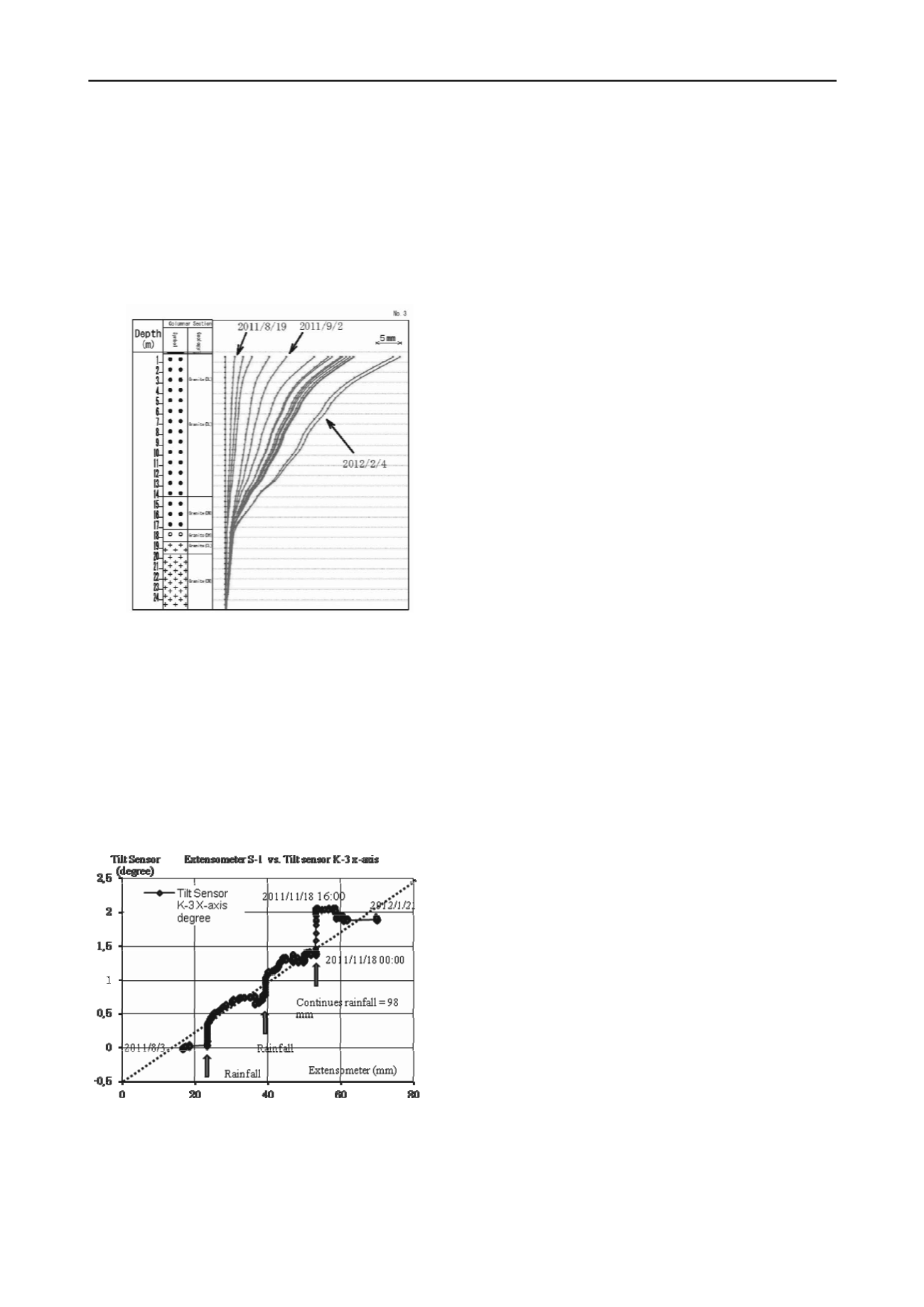
2280
Proceedings of the 18
th
International Conference on Soil Mechanics and Geotechnical Engineering, Paris 2013
fixed pole of extensometers moving point shown in Figure 10.
In this field site, other 4 boring surveys have been carried out
and multiple borehole inclinometers were installed, two of the
tilt sensors (K-2, 3) were just set up nearby the survey boring
holes. According to the result of boring survey, a landslide slip
surface, which depth was 17m, was found shown in Figure 12.
Figure 10a-b show the time histories of tilt sensor inclination
alone extensometer wire direction (tilt sensor x axis) and the
extensometer movement(S-1, S-2), Figure 10c shows the result
of cumulative rainfall value by rain gauge. Figure 10d shows
the result of volume water content by ECH2O water content
sensor.
The normal case, the fix pole of tilt sensor was inserted into
earth of slope surface at the depth of 1.0 meter, so that the
inclination of tilt sensor means average movement of the slope
surface. The inclinations of tilt sensors especially tilt sensor K-3,
and movement of extensometers were increased with rainfall
and showed a strong correlation each other based on the results
of Figure 10a-e.
Figure 13 shows the relation of slope movement (mm) by
extensometer(S-1) vs. inclination (degree) by tilt sensor (K-3).
Based on the result, the almost linear relationship between
extensometer and tilt sensor was obtained except for the storms
period of August, October and November, 2011.
Another important result is that between heavy rainfall start
and landslide initiation, the value of extensometer seems no any
change but the tilt sensor inclination has reacted quickly, for
example, the heavy rainfall on 18 November 2011, that hourly
rainfall reached 20mm and continues rainfall reached 96mm,
run continuously for 16 hours, during this period, the inclination
of tilt sensor was increased but the value of extensometer
showed no any change (Figure 13). The tilt sensor measures a
local change of slope surface, and the extensometer measures a
whole movement of slope failure or landslide. The failure of
slope starts from local and enlarges to whole area usually, so
that this result should be considered as an important slope pre-
failure phenomenon, which can let warning system to issue
useful information to residents to avoid slope failure or
landslide disaster in advance.
2 CONCLUSION
Figure 12. The result of multiple borehole inclinometers
.
Based on above case histories and field validation result, a low-
cost and simple monitoring method of measuring tilting motion
on these slope surface is effective and proposed for precaution
of rainfall-induced slope failure and landslides; The tilt sensor
unit with MEMS inclinometer module and wireless module is
very save power and installed easily. At a side slope of Three
Gorge Dam in China, consecutive movement of a sliding block
was observed for a long period.
A quick movement was detected at a heavy rainfall event, in
which a tilting rate of about 3 degrees per day was continued for
2 days. This event includes a slope failure and significant
displacement in a wide area including the position of the sensor
unit.
At a slope failure site along a national road in Japan, the
slope surface showed abnormal tilting behaviors 30 to 50
minutes before failure. The tilting rate was around 3 degrees per
day, although it continued for only 50 minutes before failure.
Such behaviors could be used as a signal for early warning.
Furthermore, between heavy rainfall and landslide initiation,
the tilt sensor inclination has reacted quickly than extensometer
value; it can be considered that the tilt sensor unit is effective
tool for early warning system.
3 ACKNOWLEDGEMENTS
The present study has been supported by the research funding
supplied by JSPS of Japanese government as well as the
Science Academy of China. These research assistants are deeply
acknowledged by the authors.
4 REFERENCES
Orense R.P., Towhata I., Farooq, K. 2003. Investigation of failure of
sandy slopes caused by heavy rainfall.
Proc. Int. Conf. on Fast
Slope Movement-Prediction and Prevention for Risk Mitigation
(FSM2003)
, Sorrento.
Figure 13. The relation of slope movement vs. tilt angle.
Towhata,I., Uchimura,T. and Gallage,C.P.K. 2005. On early detection
and warning against rainfall-induced landslide.
Proc. of The First
General Assembly and The Fourth Session of Board of
Representatives of the International Consortium on Landslides
(ICL)
. Washington D.C., Springer, pp.133-139.
Uchimura, T., Towhata, I., Wang, L. and Seko, I. 2008. Simple and
Low-Cost Wireless Monitoring Units for Slope Failure.
Proc. of the
First World Landslide Forum, International Consortium on
Landslides (ICL)
. Tokyo, pp. 611-614.
Uchimura, T., Towhata, I., Wang, L. and Seko, I. 2009. Development of
Low-cost Early Warning System of Slope Instability for Civilian
Use.
Proc. of 17th ISSMGE
. Alexandria, Vol. 3, pp.1897-1900.
Uchimura, T., Wang, L., Qiao, J.P., and Towhata, I. 2011. Miniature
ground inclinometer for slope monitoring.
Proc. of the 14th Asian
Regional Conference on Soil Mechanics and Geotechnical
Engineering
, Hongkong.


